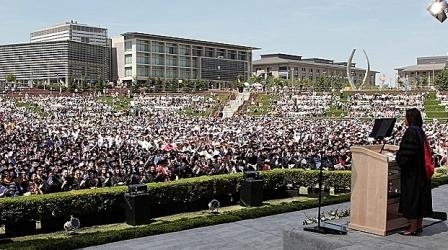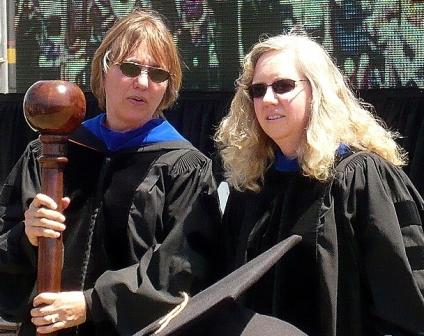June 2009
UC Merced: A Campus worth Funding
To the 10,000 students, faculty, parents, staff, and community leaders assembled on the grassy UC Merced Quad listening to First Lady Michelle Obama deliver the commencement address at the campus’s first-ever graduation, the once empty field that housed only a dream a few years ago was a distant memory. That field was now surrounded by the world-class research facilities, classrooms, and residential buildings of the 10th UC campus.
Merced welcomed its first students in September 2005, and the campus continues to grow rapidly—increasing student enrollment by more than 45% each year for the past two years and by 25% this year, bringing the projected total to 3400 students in September 2009.
 |
Michelle Obama delivers the commencement address at the UC Merced graduation on May 16, 2009 (Photo: UC Merced) |
Professor of Engineering and Merced Academic Senate Division Chair Martha Conklin was one of the 13 founding faculty members who arrived at temporary quarters at the old Castle Air Base near that empty field in 2003 to help build what would be the first new UC campus in 40 years. She and the now 120-strong Merced faculty have built—literally from the ground up—an impressive array of curricula, research programs, and service-related institutions.
Professor Conklin is enthusiastic about the progress being made at the young campus, and is eager for its faculty and students to be recognized for their academic and research achievements. She notes that 68% of Merced undergraduates have assisted faculty with research or created projects. She also points to Merced’s early success in developing environmental science programs focused on alternative energy and hydrology, and singles out the Computational Intelligence program as a model of interdisciplinary collaboration that Merced wants to continue building into its research culture. “Being able to establish an open academic environment, rather than a siloed one, will help Merced develop quickly into an academic leader,” she said.
Merced already is known for its diverse student body. Professor Conklin says she expects UC Merced to be designated a Hispanic-serving institution after the upcoming WASC accreditation process is finished. She also notes that the campus has the highest percentage of first-generation students of any UC campus, which carries both advantages and disadvantages. “It is fantastic that our student body is so diverse,” she said. “It helps us foster community relations, and the students have been great ambassadors for UC and higher education in general to local high school students. First-generation students, however, are also those most at risk for academic difficulty, so establishing mentoring and academic preparation programs has been a priority for the Senate and administration.”
But the campus also faces daunting budgetary challenges. Professor of Cognitive Science Evan Heit, who also chairs Merced’s Senate Committee on Academic Planning and Resource Allocation, says it has been difficult for Merced to absorb new state budget cuts while it is attempting to grow into a first-rate research institution on a par with the other nine campuses. He notes that Merced only has two academic buildings, and although a third building is under construction, the State has suspended funding due to the budget crisis, and has yet to approve funding for two major capital projects. He says long- and short-term strategic planning is constantly hampered by budget uncertainties and construction and funding delays. Physical limitations on campus impede certain aspects of research and teaching, and a lack of sufficient laboratory and classroom space hinders faculty and graduate student recruitment and retention.
He recalls that the Academic Council’s memo of concern about the UC Merced budget situation in July 2008 prompted a dialogue among the Council, President Yudof, and Merced. Council’s recommendations helped draw attention to Merced’s budget issues and improved communication between the campus and UCOP, but problems sill remain.
“Last year Council recommended that the Science and Engineering 2 building and the renovation of the off-campus Castle laboratories, ‘should be given highest priority among UC’s capital projects,’ says Professor Heit. “However, these projects are still unfunded. Our laboratories are full, so this has an immediate impact on faculty and graduate student recruitment in the sciences. We’ve basically hit the wall. Our faculty have been successful so far—Presidential awards and strong grant numbers—but we need to grow to build critical mass in research, which will help our assistant professors attract graduate students and get tenure. About two-thirds of our faculty are assistant professors.”
Professor Heit notes that the campus is growing, but there is a very small capital base on which to balance the growth. All recent capital growth—temporary trailers, for example—comes out of the operating budget, which directly affects educational quality. The current budget environment also has forced Merced to implement a number of drastic cost savings measures. About 2/3 of Merced’s faculty searches have been cancelled, staff hiring has been frozen, and plans for new programs and facilities have been delayed. And while all UC campuses are hurting, Merced is facing higher-than-average costs associated with building a new campus, including infrastructure development costs. Finally, because the state is funding only 2,000 of its 3,000 students, based on the average per student marginal cost of instruction rate, Merced is at a distinct disadvantage compared to other UC campuses.
“Everyone, from the Senate to the most senior leadership at UCOP, acknowledges that Merced’s budget model is flawed,” says Professor Heit. “Merced gets 57% of its revenues from the State, whereas the other campuses average 20%, so we are heavily dependent on the system. Yet Merced is only 0.5% of the systemwide budget, so cutting the Merced budget would barely help the system. The faculty are so stretched now—there are on average six faculty per major—it’s a challenge to cover upper-division courses not to mention graduate courses. It’s getting harder to fill Senate committees. We simply want to grow to a sustainable level, financially and academically—that means adding more students and more faculty. It would be devastating to morale if we stopped growing—the status quo is not sustainable.”
 |
Martha Conklin and Mary Croughan lead the procession of faculty at the UC Merced graduation. (photo: Evan Heit) |
Although Merced is projecting enrollment of 3,400 students next year, it has State enrollment support for only 2,000, and must find a way to stay on its growth trajectory without that support. In 2008, UCOP provided last minute funding to cover over-enrollment at Merced and may do so again this year, but the annual uncertainty about the UC Merced budget and last minute negotiations make it difficult to plan long-term. “There is uncertainty throughout the system but the other campuses each have tens of thousands of guaranteed, funded student places. At Merced, very little is guaranteed. The faculty, staff, and students have accomplished so much—the students have been successful beyond our wildest dreams—but when it comes to planning we have to expect the worst every year. Having a multi-year growth plan agreement between Merced and UCOP to bring us to a sustainable position would help us make the best decisions in terms of faculty hiring and program development.”
Professor Conklin adds that because each process has to be created from scratch, even routine items have been a struggle. “But these obstacles, and the fact that they are being overcome, only illustrate the dedication and innovation of our faculty,” she said.” With the establishment and staffing of the Senate office and development of the policies and procedures in consultation with the administration, Merced is well on the path to shared governance.
Merced has assembled an accomplished, dedicated faculty, but because only about one third of them are tenured, a tremendous amount of work has fallen on a handful of individuals. Everything from participating in merit and promotion review committees, to strategic planning, to developing by-laws and accreditation materials involves faculty time. Professor Conklin says she is grateful for the help of the Merced faculty and other UC faculty who have contributed their experience and expertise in helping the Merced campus become integrated into the UC system.
“The Merced faculty have been incredibly busy, but they’ve also been incredibly successful. The willingness of other UC faculty to work with us in developing Senate by-laws, academic programs, and Conflict of Interest guidelines has been invaluable, both in terms of easing our workload and in helping us feel like we are part of a greater whole. Our faculty’s connections also have helped facilitate a good working relationship with the Office of the President.”
Professor Conklin says Merced’s San Joaquin Valley location is far from a liability. “Although many agriculturally-based economies are struggling, the opportunities here far outweigh the costs. Proximity to the Sierra Nevada and the vast agricultural hub of the Central Valley offer UCM faculty unique and easy access to resources socially relevant research opportunities. Some of the major health issues of the San Joaquin Valley—high rates of smoking and teenage pregnancy, asthma, and diabetes—are best approached by prevention and Merced is developing a health science research program. One of our professors, Henry Jay Forman, was appointed by the Governor as the first scientist member of the Governing Board of the San Joaquin Valley Unified Air Quality District.”
And the benefits are reciprocal: in only four years, local high schools already have seen an increase in their graduation rates. As the campus matures, the possibilities seem limitless.
Professor Conklin also praised the students of her young campus. “The student activism and dedication embodied in the effort to secure Michelle Obama’s participation in commencement is inspiring both to the faculty here and to our greater Merced community.” As a result, not only does the world know about UC Merced, but more importantly, they know about the campus’s unique student body, its diversity, and its collective commitment to making UC Merced another world-class UC campus.
Academic Senate Chair Mary Croughan agrees that the graduation was spectacular. “The campus should be very proud of its students’ work in getting Michelle Obama to be the commencement speaker,” she said. “I thought her speech was one of the most inspiring I’ve ever heard. The founding Merced faculty have had the toughest job of anyone, taking on heavier than average teaching loads and filling multiple roles that go far beyond what is expected of faculty on other campuses. But they have risen to the occasion. They have done an exceptional job of building the campus while staying committed to the goal of developing a first-rate research institution in spite of having insufficient resources and classroom and laboratory space.”
Looking to the future, Professor Conklin has set her divisional sights on being perceived as a co-equal campus. “UC is still One University, but each of our sister campuses are at different stages of growth. Being recognized as an equal in this august group is our main goal.” While attaining that may still take some time, Merced is well on its way.
Watch highlights of UC Merced’s graduation here:
http://www.ucmerced.edu/commencement/
